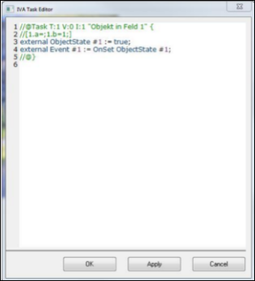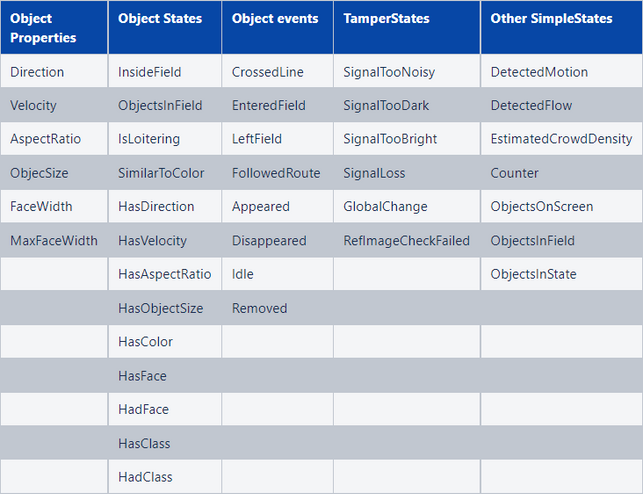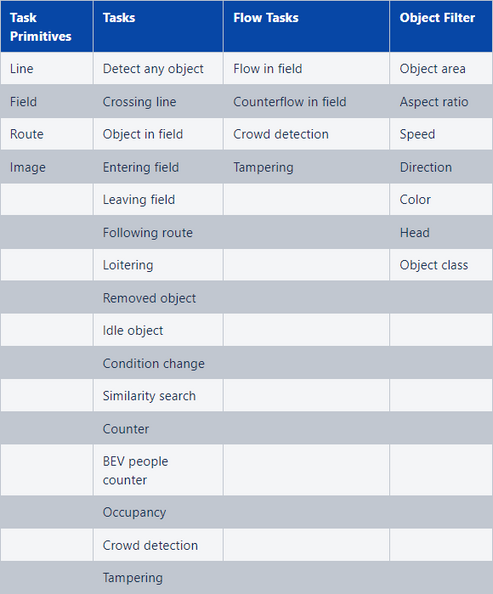- Top Results
- Bosch Building Technologies
- Security and Safety Knowledge
- Security: Video
- How to use the VCA Task Script Language?
How to use the VCA Task Script Language?
- Subscribe to RSS Feed
- Bookmark
- Subscribe
- Printer Friendly Page
- Report Inappropriate Content
This articles gives a short introduction to scripting alarm and counter tasks with Intelligent and Essential Video Analytics in FW 7.60. It also provides a broad selection of example scripts for explanation as well as including real world application examples.
Step-by-step guide
1 What is the VCA task script language?
VCA stands for video content analysis. The VCA task script language:
- describes every predefined and configured Intelligent Video Analytics, Essential Video Analytics and MOTION+ task and task wizard
- can combine tasks to form more complex ones
- can NOT configure the metadata generation

1.1 When to use the VCA task scripts?
The VCA task scripts are used implicitly whenever an Intelligent Video Analytics, Essential Video Analytics or MOTION+ task is configured via the GUI. However, manual configuration of the VCA task scripts is also possible and advised whenever the predefined tasks are not enough:
- For backup and exchange of the configured tasks, the script can be copied from and pasted into the task script editor.
- When more than 8 alarm tasks are needed: 16 external alarm tasks are configurable via VCA task scripts.
- Fine tuning the position of lines and fields.
- Line combinations for counting with FW < 6.30.
- Don’t touch (museum mode) with FW < 6.10: Alarm needs to be triggered by any part of bounding box, not only by the object center.
- Logical combinations of predefined events are needed.
1.2 How to use VCA task scripts?
(1) Define all tasks via task wizards as far as possible.
(2) Change to the VCA task script editor. The already defined tasks can be found there with all details.
(3) Make your modifications.
(4) Change the defined tasks into task type scripted so accidental use of the task wizards will not overwrite your changes.
1.3 How to access the VCA task script language?
Go to the Intelligent Video Analytics, Essential Video Analytics or MOTION+ configuration and open the task page.
Right-click on the video and select Advanced -> VCA Task Editor. A separate popup with the current VCA task script will appear:


1.4 Task & object filter overview
A task consists of
- A task primitive
- An object state or interaction with a task primitive
- A filter on the object properties if task is based on objects
Note that not all tasks and filters are available in every FW version.
MOTION+:

Intelligent Video Analytics & Essential Video Analytics (the latter w/o flow tasks):
1.5 Object state and event overview
From the task primitives, the tasks and the object filter as defined in the GUI via the task wizards, target object states and events are derived. These can also be defined directly in the VCA task script language.
Events are always temporal relations
- Up to 8 external events can be shown in GUI
- Up to 16 external events can be defined in total
- Up to 32 events can be defined in total
States can be, amongst others, spatial relations, object properties, tamper states, counter values
- Up to 16 external states can be defined
- Up to 32 states in total can be defined
Events and states can be internal or external. Only external events and states are outputted.
Simple states are used whenever a property has no corresponding objects. Examples are Motion+, Flow, counter values and tamper states.

1.6 Combining & converting object states and events
The combinations of object states and events listed below are possible. Object states can be also converted into events, but only the onset or leaving of an object state is an actual event, not the actual duration of the object in this state.

1.7 Temporary states for time evaluations
Starting with FW 6.60 and in order to create temporary states triggered by an event, the keyword within can used after an event. This can be used to
- delay or debounce an alarm based on an object state: within(0,)
- to extend an alarm state similarly to the aggregation time: within(,*)
- debouncing object properties: By checking the target values is currently met, and has not changed during the debounce time
- temporarily combine an event with other states
1.8 Position descriptions
There are two different ways to describe the position information of lines, fields and routes:
- Absolute pixel position, e.g. Point(103, 30). You need to know exactly which resolution is used in the video analytics for that.
- Relative coordinates, e.g. specifying
Resolution := { Min(-1, -1) Max(1, 1) };
Line #1 := { Point(-0.85, 0.95) Point(-0,6, 0.4)};
Here, the coordinates are defined within the specified resolution and transferred automatically to the real resolution used in the video analytics.
2 Examples & Explanations
2.1 Understanding the VCA task script language: Line Crossing, GUI
| //Definition of task primitives Line #1 := { Point(103, 30) Point(159, 77)}; Line #2 := { Point(26, 65) Point(82, 122) DebounceTime(0.50) Direction(1) }; //Definition of alarm task shown in GUI //@Task T:2 V:0 I:1 "Crossing line 1" { //[1.a=s1:1;1.b=1;1.c=32;1.d=31;4.a=i:1;] external Event#1 :={CrossedLine#1}; //@} //Definition of self-defined task shown in GUI //@Task T:0 V:0 I:2 "Crossing line 2" { external Event#2 :={CrossedLine#2}; //@} //Definition of alarm task not shown in GUI external Event#3 :={CrossedLine#2}; |
 |
2.2 Understanding the VCA task script language: Polygonal lines
| //Definition of task primitives Resolution := { Min(-1, -1) Max(1, 1) }; Line #1 := { Point(-0.85, 0.95) Point(-0.6, 0.4) Point(0.6, 0.4) Point(0.85, 0.95) DebounceTime(0.50) Direction(2) TriggerPoint(FootPoint) }; //Definition of alarm task shown in GUI //@Task T:2 V:0 I:1 "Crossing line 1" { //[1.a=s1:1;1.b=1;1.c=32;1.d=31;4.a=i:1;] external Event#1 :={CrossedLine#1}; //@} |
|
2.3 Understanding the VCA task script language: Line crossing with object filters
| //Definition of task primitives Line #1 := { Point(103, 30) Point(159, 77)}; //@Task T:2 V:0 I:1 "Crossing line 1" { //[1.a=s1:1;1.b=1;1.c=32;1.d=31;3.o=(b1:1, b2:0.1,b3:500, c1:1,c2:0.02,c3:34.00,d1:1, d2:0,d3:27.78,e1:1,e2:315, e3:45,f1:1,f2:135, f3:225);4.a=(c:2b19,i:1,pr:2);5.a=(c:1,p:1); 6.a=(d1:8,d2:33,r:2,u:1);] ColorHistogram #1:= { HSV(60,38,100,25) Similarity(75) Outlier(75) }; external Event#1:={CrossedLine#1 where ObjectSize within(0.1,500) and AspectRatio within(0.02,34.00) and Velocity within(0,27.78) and (Direction within(315,405) or Direction within(135,225)) and SimilarToColor #1 and HadFace and MaxFaceWidth within(8,33)}; //@} |

|
2.4 Understanding the VCA task script language: Fields
| //Definition of task primitives Field #1 := { Point(56, 24) Point(106, 24) Point(106, 74)}; Field #2 := { Point(56, 24) Point(106, 24) Point(106, 74) Point(56, 74) DebounceTime(0.50) ObjectSet(BoundingBox) SetRelation(Covering)}; //@Task T:1 V:0 I:1 "Object in field 1" { //[1.a=1;1.b=1;3.a=i:1;] external ObjectState #1 := InsideField #1; //@} |

|
2.5 Understanding the VCA task script language: Routes
| //Definition of task primitives Route #1 := { Point(34, 111) Distance(5) Point(92, 125) Distance(5) Point(140, 104) Distance(5) Point(143, 72) Distance(5) MinPercentage(80) MaxGap(10) }; //@Task T:6 V:0 I:1 "Follow route 1" { //[1.a=id:1;1.b=1;3.a=i:1;] external Event #1 := { FollowedRoute #1 }; //@} |

|
2.6 Example: Alarm if object enters a field and afterwards crosses the line
| //Definition of task primitives Resolution := { Min(-1, -1) Max(1, 1) }; Field #1 := { Point(-0.6, 0.95) Point(-0.25, -0.95) Point(0.25, -0.95) Point(0.6, 0.95) DebounceTime(0.50) }; Line #1 := { Point(0.0, -0.95) Point(0.0, 0.95) DebounceTime(0.50) }; //@Task T:0 V:0 I:1 "Enter Field and Line" { external Event#1:={EnteredField #1 before (*,30) CrossedLine #1 where first.oid == second.oid }; //@} |

|
2.7 Example: Alarm if object enters first one field and then the other
| //Definition of task primitives Resolution := { Min(-1, -1) Max(1, 1) }; Field #1 := { Point(-0.6, 0.95) Point(-0.25, -0.95) Point(-0.1, -0.95) Point(-0.1, 0.95) DebounceTime(0.50) }; Field #2 := { Point(0.6, 0.95) Point(0.25, -0.95) Point(0.1, -0.95) Point(0.1, 0.95) DebounceTime(0.50) }; //@Task T:0 V:0 I:1 "Enter Field and Line" { external Event#1:={EnteredField #1 before (*,30) EnteredField#2 where first.oid == second.oid }; //@} |

|
2.8 Example: Perimeter protection with two fields
| //Definition of task primitives Resolution := { Min(-1, -1) Max(1, 1) }; Field #1 := { Point(0.406, -0.644) Point(0.250, -0.656) Point(-0.213, 1.000) Point(0.400, 1.000) DebounceTime(0.10) }; Field #2 := { Point(0.181, -0.667) Point(-0.388, 1.000) Point(-0.588, 1.000) Point(0.088, -0.678) DebounceTime(0.10) }; //@Task T:0 V:0 I:1 " Field combination" { ObjectState #16 := InsideField #1 and ObjectSize within(0.7,10) ; ObjectState #17 := InsideField #2 and ObjectSize within(0.7,10) ; external Event #1 := { OnSet ObjectState #16 before OnSet ObjectState #17 where first.oid==second.oid}; //@} |

|
2.9 Example: Combining lines for counting
| //Definition of task primitives Line #1 := { Point(0, 90) Point(60, 90) DebounceTime(0.10) Direction(1) }; Line #2 := { Point(60, 90) Point(90, 60) DebounceTime(0.10) Direction(1) }; Line #3 := { Point(90, 60) Point(90, 0) DebounceTime(0.10) Direction(1) }; //@Task T:0 V:0 I:1 "Counter 1" { Event#32 :=CrossedLine#1 or CrossedLine#2 or CrossedLine#3; external Counter#1 := { Event#32 Text("Corner Count1:") TopLeft(4,4) Mode(Wraparound) within(0,999999999) }; //@} |

|
2.10 Example: Crossing line1 with 60km/h and line 2 with 20km/h
| //Definition of task primitives Line #1 := {Point(50,0) Point(50,144)}; Line #2 := {Point(120,0) Point(120,144)}; //Definition of line crossing events Event#11 :={CrossedLine#1 where Velocity within(13.89,19.44) }; Event#12 :={CrossedLine#2 where Velocity within(2.778,5.556) }; //Combination of line crossing events //@Task T:0 V:0 I:1 "Two Line Speed Check" { external Event#1 :={Event#11 before Event#12 where first.oid==second.oid}; //@} |

|
2.11 Example: Stopping in area after crossing line
| //Definition of task primitives Line #1 := { Point(130, 0) Point(130, 144) }; Field #2 := { Point(50, 0) Point(115, 0) Point(115, 144) Point(50, 144)}; //@Task T:0 V:0 I:1 "Loitering after Line Crossing" { Event#11 :={CrossedLine #1}; Loitering #13 := { Radius (15) Time (10) }; ObjectState #14 := InsideField #2 and IsLoitering #13; external Event #1 := {Event #11 before OnSet ObjectState #14 where first.oid==second.oid}; //@} |

|
2.12 Example: Alarm When Object Touches Area
| //Definition of task primitives Field #1 := { Point(100, 0) Point(175, 0) Point(175, 144) Point(100, 144) ObjectSet(BoundingBox)}; //@Task T:0 V:0 I:1 "Object Touches Field" { ObjectState #1 := InsideField #1; external Event #1 := OnSet ObjectState #1; //@} //Alternative, objects have to come from the outside of the field: //@Task T:0 V:0 I:2 "Object Touches Field" { external Event #2 := EnteredField #1; //@} |

|
2.13 Example: Alarm when object enters an area at least 4 times
| //Definition of task primitives Resolution := { Min(-1, -1) Max(1, 1) }; Field #1 := { Point(-0.244, -0.922) Point(0.325, -0.944) Point(0.350, 0.944) Point(-0.231, 0.944) DebounceTime(0.50) }; //@Task T:0 V:0 I:1 "Thieve detection" { Event #11 :={EnteredField #1 before EnteredField #1 where first.oid==second.oid}; Event #12 :={Event #11 before EnteredField #1 where first.oid==second.oid}; external Event#1 :={Event #12 before EnteredField #1 where first.oid==second.oid}; //@} |

|
2.14 Example: Alarm when a second object crosses a line within 3 seconds of the first
| //Definition of task primitives Resolution := { Min(-1, -1) Max(1, 1) }; Line #1 := { Point(-0.187, -0.967) Point(-0.156, 0.911) DebounceTime(0.50) Direction(2) TriggerPoint(FootPoint) }; //@Task T:0 V:0 I:1 "Tailgaiting" { Event#21:={CrossedLine#1}; Event#22:={CrossedLine#1}; external Event#1:={Event#21 before(0,3) Event#22 where first.oid!=second.oid}; //@} |

|
2.15 Example: Alarm when at least 2 object are in an area
| //Definition of task primitives Resolution := { Min(-1, -1) Max(1, 1) }; Field #1 := { Point(-0.656, -0.700) Point(0.350, -0.767) Point(0.469, 0.644) Point(-0.694, 0.644) DebounceTime(0.10) }; //@Task T:0 V:0 I:1 "Alarm on more than two objects" { external ObjectState #1:= ObjectsInField#1 within (2,*); //@} |

|
2.16 Example: Count the number of objects in an area
| //Definition of task primitives Resolution := { Min(-1, -1) Max(1, 1) }; Field #1 := { Point(-0.656, -0.700) Point(0.350, -0.767) Point(0.469, 0.644) Point(-0.694, 0.644) DebounceTime(0.10) }; //@Task T:0 V:0 I:1 "Count of objects in field " { external Counter#1 := { ObjectsInField#1 Text("Counter:") TopLeft(-0.975,-0.844) }; //@} //@Task T:18 V:0 I:2 "Count of objects in field " { //[1.a=1;1.b=1;1.c=32;2.a=(,b3:1);] ObjectState #32 := InsideField #1; external Counter#2 := { ObjectsInState#32 Text("Occupancy:") TopLeft(-0.975,-0.744) }; //@} |

|
2.17 Example: Alarm on empty reception desk
| //Definition of task primitives Resolution:= { Min(-1, -1) Max(1, 1) }; Field #1:= { Point(-0.150, -0.700) Point(0.250, -0.700) Point(0.250, 0.600) Point(-0.150, 0.600) DebounceTime(0.10) }; Field #2:= { Point(-0.600, -0.700) Point(-0.200, -0.700) Point(-0.200, 0.600) Point(-0.600, 0.600) DebounceTime(0.10) }; //@Task T:0 V:0 I:1 "Unmanned reception" { external SimpleState #1:= ObjectsInField#1 within (1,*) and ObjectsInField#2 within (0,0); //@} |

|
2.18 Example: Alarm if one queue is empty and the other has at least 3 persons
| //Definition of task primitives Resolution:= { Min(-1, -1) Max(1, 1) }; Field #1:= { Point(-0.150, -0.700) Point(0.250, -0.700) Point(0.250, 0.600) Point(-0.150, 0.600) DebounceTime(0.10) }; Field #2:= { Point(-0.600, -0.700) Point(-0.200, -0.700) Point(-0.200, 0.600) Point(-0.600, 0.600) DebounceTime(0.10) }; //@Task T:0 V:0 I:1 "Only one queue" { ObjectState #1:= ObjectsInField#1 within (3,*); external Event #1:= {OnSet ObjectState #1 where ObjectsInField#2 within (0,0)}; //@} // To see the results of the no object check, use the following: //@Task T:0 V:0 I:2 "No object" { external SimpleState #2:= ObjectsInField#2 within (0,0); //@} |

|
2.19 Example: Virtual room for counting with one in and one out line
| //Definition of task primitives Resolution:= { Min(-1, -1) Max(1, 1) }; Line #1 := { Point(-0.1, -0.8) Point(-0.1, 0.8) DebounceTime(0.10) Direction(1) }; Line #2 := { Point(0.1, 0.8) Point(0.1, -0.8) DebounceTime(0.10) Direction(1) }; //@Task T:0 V:0 I:1 "Virtual Room" { Event#31:={CrossedLine#1}; Event#30:={CrossedLine#2}; external Counter#1 := { Event#31 Text("Linie 1:") TopLeft(4,4) }; external Counter#2 := { Event#30 Text("Linie 2:") TopLeft(4,14) }; external Counter#4 := { Counter#1 - Counter#2 Text("Virtual Room:") TopLeft(4,34) }; //@} |

|
2.20 Example: Virtual room for counting with two in and one out line
| //Definition of task primitives Resolution:= { Min(-1, -1) Max(1, 1) }; Line #1 := { Point(-0.7, -0.7) Point(0.7, -0.7) DebounceTime(0.10) Direction(1) }; Line #2 := { Point(-0.7, -0.7) Point(-0.7, 0.7) DebounceTime(0.10) Direction(1) }; Line #3 := { Point(-0.7, 0.7) Point(0.7, 0.7) DebounceTime(0.10) Direction(1) }; //@Task T:0 V:0 I:1 "Virtual Room" { Event#31:={CrossedLine#1}; Event#30:={CrossedLine#2}; Event#29:={CrossedLine#3}; external Counter#1 := { Event#31 Text("Linie 1:") TopLeft(4,4) }; external Counter#2 := { Event#30 Text("Linie 2:") TopLeft(4,14) }; external Counter#3 := { Event#29 Text("Linie 3:") TopLeft(4,24) }; Counter#32 := { Counter#1 + Counter#2}; external Counter#4 := { Counter#32 - Counter#3 Text("Virtual Room:") TopLeft(-0.9,-0.9) }; //@} |

|
2.21 Example: Alarm on any object that is not yellow
| //@Task T:0 V:0 I:1 "No yellow object" { ColorHistogram #1:= { HSV(60,100,100,20) HSV(60,100,60,20) HSV(60,100,30,20) Similarity(75) Outlier(55) }; external ObjectState #1 := not SimilarToColor #1; external Event #1 := OnSet ObjectState #1; //@} |
|
2.22 Example: Count all red objects
| //Definition of task primitives Resolution:= { Min(-1, -1) Max(1, 1) }; Line #1 := { Point(-0.1, -0.8) Point(-0.1, 0.8) DebounceTime(0.10) Direction(1) }; //@Task T:0 V:0 I:1 "Count red objects" { ColorHistogram #1:= { HSV(0,100,100,20) HSV(0,100,60,20) HSV(0,100,30,20) Similarity(75) Outlier(55) }; Event#31:={CrossedLine#1 where SimilarToColor #1}; external Counter#1 := { Event#31 Text("Linie 1:") TopLeft (-0.9,-0.9) }; //@} |

|
2.23 Example: Debouncing object size by 5 seconds
| //Definition of task primitives Resolution:= { Min(-1, -1) Max(1, 1) }; Field #1 := { Point(-0.7, -0.7) Point(0.7, -0.7) Point(0.7, 0.7) Point(-0.7, 0.7) DebounceTime(5.00) ObjectSet(FootPoint) }; //@Task T:0 V:0 I:1 "Debounce Size" { ObjectState#21 := ObjectSize within(5,500); ObjectState#22:=OnChange ObjectState#21 within (0,5); external ObjectState#1:=InsideField#1 and ObjectState#21 and !ObjectState#22; //@} |

|
2.24 Example: Give 30 sec alarm on any object (aggregation time)
| Resolution:= { Min(-1, -1) Max(1, 1) }; //@Task T:0 V:0 I:1 "30 sec alarm" { external SimpleState#1:= Appeared within(0,30); //@} |

|
Still looking for something?
- Top Results


